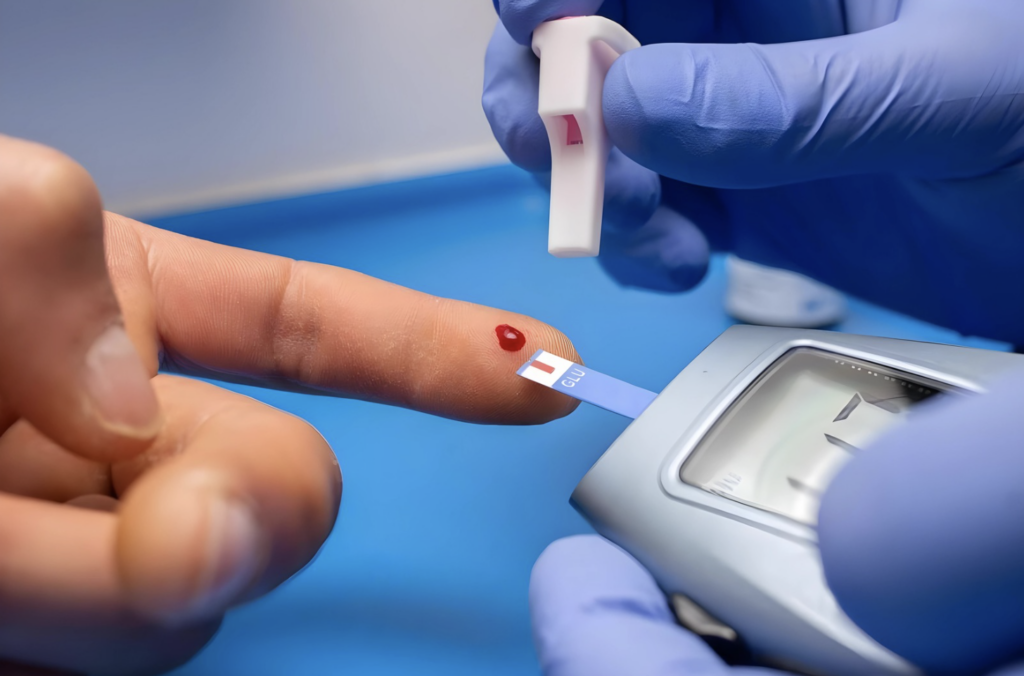Medically Accredited
What is Type 2 Diabetes: An In-Depth Guide to Symptoms, Causes, and Management
Type 2 diabetes is the most common type of diabetes. According to the World Health Organization (WHO), type 2 diabetes has become much more common in the last 30 years, and this trend has been observed across all income brackets.
It occurs when the body is unable to use insulin properly, leading to persistently high blood sugar levels. Without proper management, type 2 diabetes can have serious health consequences, including heart disease, kidney disease, and stroke. However, with lifestyle changes, medication, and regular check-ins with healthcare providers, individuals can effectively manage this condition and lead a healthy life. Read on to learn more about “what is type 2 diabetes” and see if it’s potentially reversible.
What is Type 2 Diabetes?
Type 2 diabetes, also known as T2D, is a chronic condition characterized by persistently high blood sugar levels, also known as hyperglycemia. In a healthy individual, blood sugar levels should be between 70 and 99 milligrams per deciliter (mg/dL). However, individuals with undiagnosed Type 2 diabetes typically have blood sugar levels of 126 mg/dL or higher.
Unlike Type 1 diabetes, which is caused by an autoimmune attack on the pancreas resulting in a lack of insulin production, Type 2 diabetes occurs when the body either doesn’t produce enough insulin or is unable to use it effectively.
Type 2 diabetes is incredibly common, affecting approximately 6.3% of the world’s population. In the United States alone, more than 38 million people have diabetes, with 90% to 95% of them having Type 2 diabetes. While the condition most commonly affects adults over 45 years old, it can also develop in individuals younger than 45, including children.
What are the Symptoms of Type 2 Diabetes?
Type 2 diabetes often develops slowly, and the early symptoms may be mild and easily dismissed. As the disease progresses, the symptoms can become more severe and lead to potentially dangerous complications. High blood glucose levels can cause eye problems, numbness in the extremities, kidney disease, gum disease, and an increased risk of a heart attack or stroke. It’s important to be aware of these symptoms and seek medical attention if you experience them. The most common symptoms include:
- Increased thirst (polydipsia)
- Frequent urination
- Increased hunger (polyphagia)
- Fatigue
- Slow healing of cuts or sores
- Tingling or numbness in the hands or feet
- Blurred vision
- Dry skin
- Unexplained weight loss
It’s important to note that individuals assigned female at birth may experience frequent vaginal yeast infections and/or urinary tract infections (UTIs). If you experience any of these symptoms, don’t assume that it’s diabetes right away; it’s still important to see your healthcare provider for a proper diagnosis.
What Causes Type 2 Diabetes?
Insulin resistance is the primary cause of type 2 diabetes. Insulin resistance occurs when cells in the muscles, fat, and liver do not respond properly to insulin, a hormone responsible for regulating blood sugar levels. To compensate for this resistance, the pancreas produces more insulin, leading to hyperinsulinemia. If the cells continue to be resistant to insulin and the pancreas can’t produce enough insulin to overcome it, type 2 diabetes develops.
Several factors contribute to insulin resistance, including genetics, excess body fat (especially around the belly and organs), physical inactivity, a diet high in processed carbohydrates and saturated fats, certain medications, hormonal disorders, chronic stress, and a lack of quality sleep.
What are the Risk Factors for Type 2 Diabetes?
Several risk factors are associated with an increased likelihood of developing type 2 diabetes. You’re more likely to develop Type 2 diabetes if you:
- Are overweight (having more than 25 as BMI)
- Live a sedentary lifestyle
- Are more than 45 years old
- Have a family history of type 2 diabetes
- Have prediabetes
- Have high blood pressure
- Have developed gestational diabetes while pregnant
- Have polycystic ovarian syndrome (PCOS)
- Are Indian, Alaska Native, Hispanic/Latino, and Non-Hispanic Black
Below chart shows the prevalence of type 2 diabetes based on age and race/ethnicity in USA:
Source Study: Racial/ethnic differences in the burden of type 2 diabetes over the life course: a focus on the USA and India
As mentioned, type 2 diabetes is the most common type of diabetes, but its prevalence varies widely by geographical region and by race/ethnicity. For example, the figure above shows age-specific prevalence of diagnosed diabetes in the USA, according to self-reported race/ethnicity. In older adults with more than 75 years of age, prevalence ranges from 17.7% in non-Hispanic white individuals to 45.2% in American Indians/Alaska Natives.
If you have these risk factors mentioned above, it’s important to regularly consult your healthcare provider for screenings to check your blood sugar levels. It’s better to diagnose type 2 diabetes early to avoid complications.
How to Diagnose Type 2 Diabetes?
Diagnosing type 2 diabetes typically involves blood tests to measure blood sugar levels. The following tests are commonly used:
- Fasting Plasma Glucose Test: This test measures blood sugar levels after an eight-hour fast. A result of 126 mg/dL or higher indicates diabetes.
- Random Plasma Glucose Test: This test measures blood sugar levels at any time, regardless of fasting. A result of 200 mg/dL or higher indicates diabetes.
- A1C Test: This test provides an average of blood sugar levels over the past two to three months. A result of 6.5% or higher indicates diabetes.
In some cases, healthcare providers may order additional tests, such as an autoantibody blood test, to differentiate between type 2 diabetes and type 1 diabetes.
What’s the Treatment for Type 2 Diabetes?
Although there is currently no cure for type 2 diabetes, it is manageable. The treatment of type 2 diabetes primarily involves lifestyle changes, blood sugar monitoring, and medication. Working closely with a healthcare team, you can effectively manage the condition and minimize the risk of complications.
Lifestyle changes
Lifestyle changes play a crucial role in managing Type 2 diabetes. These changes include:
- Regular exercise: Physical activity helps lower blood sugar levels, promotes weight loss, improves blood flow and blood pressure, boosts energy levels, and aids in stress management. Aim for at least 150 minutes of moderate-intensity physical activity per week but consult with your healthcare provider before starting any exercise program.
- Healthy diet: Work with a registered dietitian to develop a meal plan that suits your needs. A balanced diet consisting of lean proteins, non-starchy vegetables, healthy fats, and complex carbohydrates can help regulate blood sugar levels.
- Weight management: Maintaining a healthy weight can improve insulin sensitivity and overall blood sugar control.
- Quit smoking: Smoking increases the risk of complications associated with diabetes.
Monitoring Blood Sugar
Regular blood sugar monitoring is important for individuals with type 2 diabetes. It provides valuable insights into how well their current treatment plan is working and helps in making decisions about food, physical activity, and medication dosage. You can monitor blood sugar using a glucose meter and finger stick or a continuous glucose monitor (CGM).
Source: The American Diabetes Association (ADA)
Medications
In addition to lifestyle changes, healthcare providers may prescribe medication to help manage type 2 diabetes. Common medications include:
- Oral diabetes medications: Individuals who still produce some insulin can take these medications orally to help regulate blood sugar levels. Metformin is the most prescribed oral diabetes medication. Below is a list of other oral diabetes medications and a summary of their characteristics.
Source: Stewart M. (2022). An overview of the oral medicines used in the management of type 2 diabetes. Nursing standard (Royal College of Nursing Great Britain)
- GLP-1 and dual GLP-1/GIP agonists: These injectable medications primarily help manage blood sugar levels and may also assist with obesity.
- Synthetic insulin: This medication immediately lowers blood sugar levels. It can be administered through injections, inhalation, or an insulin pump.
- Other medications: Individuals with Type 2 diabetes may also require medication to manage coexisting conditions such as high blood pressure and high cholesterol.
Before taking any medications, it’s important to consult with your healthcare provider first to determine the appropriate medications and needed dosage for you.
What’s the Outlook for Individuals with Type 2 Diabetes?
The outlook for individuals with type 2 diabetes depends on a variety of factors, including age at diagnosis, blood sugar level control, the presence of other conditions like high blood pressure or high cholesterol, access to healthcare, and support from loved ones. With proper management and a comprehensive healthcare team, individuals with type 2 diabetes can lead healthy lives and minimize the risk of complications.
What are the Complications of Type 2 Diabetes?
Poorly managed type 2 diabetes can lead to various complications, affecting different parts of the body. Complications of type 2 diabetes may include:
Long-term Complications
- Cardiovascular disease: Type 2 diabetes increases the risk of coronary artery disease, peripheral artery disease, cerebrovascular disease, heart attacks, and strokes.
- Eye conditions: Diabetes-related retinopathy, diabetes-related macular edema, cataracts, glaucoma, and blindness are potential complications.
- Kidney disease: Diabetes-related nephropathy can cause kidney damage and impair renal function.
- Nerve damage: Diabetes-related neuropathy can result in numbness, tingling, pain, and loss of sensation in the extremities.
- Skin conditions: Dry skin and an increased risk of bacterial and fungal infections are common in individuals with diabetes.
- Foot problems: Diabetes can lead to foot ulcers, infections, and, in severe cases, gangrene, and amputation.
- Gum disease and oral health problems: Individuals with diabetes are at a higher risk of gum disease and other oral health issues.
- Hearing loss: Diabetes is associated with an increased risk of hearing loss.
- Digestive problems: Gastroparesis, a condition characterized by delayed stomach emptying, can occur in individuals with diabetes.
- Sexual dysfunction: Diabetes can contribute to sexual dysfunction in both men and women.
Short-term complications
Hyperglycemic hyperosmolar nonketotic syndrome (HHNS) is a life-threatening complication of type 2 diabetes. It occurs when blood sugar levels are extremely high for an extended period, leading to severe dehydration and confusion. Symptoms of HHNS include:
- Abnormally high blood sugar levels
- Changes in mental state
- Loss of consciousness
- Dry mouth
- Extreme thirst
- Frequent urination
- Blurred vision
- Weakness or paralysis
More warning signs of this condition are listed in the figure below.
Immediate medical treatment is necessary for HHNS, so it’s important to seek emergency care right away if you’re experiencing these symptoms.
Emerging Complications
Recent advancements in diabetes management have shed light on potential links between type 2 diabetes and various complications, including cancer, infections, cognitive impairment, liver disease, and affective disorders. Discussions of diabetes morbidity and mortality have briefly mentioned these emerging complications, but there are currently no comprehensive reviews specifically analyzing the evidence supporting these associations.
How to Live Well with Type 2 Diabetes?
Managing type 2 diabetes requires daily care, effort, and planning. Here are some tips to help individuals with type 2 diabetes take better care of themselves:
- Stick to a healthy lifestyle: Incorporate regular exercise and healthy eating habits into your daily routine. Set small goals and make one change at a time to prevent getting overwhelmed.
- Regularly check blood sugar levels: Blood sugar monitoring is crucial for managing diabetes and preventing complications. Follow your healthcare provider’s guidance on how often to check your blood sugar.
- Take medication as prescribed: Adhere to your healthcare provider’s instructions for taking any prescribed medications.
- Regularly see your healthcare provider for diabetes: Regular appointments with your healthcare team are essential to make sure your management plan is effective. Don’t hesitate to ask specific questions and seek guidance.
- See other healthcare providers regularly: Visit your eye doctor at least once a year to monitor the health of your eyes, as diabetes can lead to complications in this area. Additionally, coordinate with other healthcare providers to manage coexisting conditions.
- Have a sick day plan: Talk to your diabetes healthcare provider about how to manage your condition when you’re sick. Illness can impact blood sugar levels and potentially trigger complications.
- Stay educated: Continuously learn about type 2 diabetes and your management plan. Knowledge empowers you to make informed decisions and prevent complications.
- Find a community: Connect with others who have type 2 diabetes, either in person or online. Building a support network can provide encouragement and understanding.
- Prioritize mental health: Living with a chronic condition can be challenging, and individuals with diabetes are at a higher risk of depression and anxiety. Seek support from a mental health professional if needed.
Regular appointments with healthcare providers and ongoing management efforts are important for effectively living with type 2 diabetes.
Frequently Asked Questions
1. Can Type 2 Diabetes be Reversed?
Although there is no cure for type 2 diabetes, research shows that some individuals can reverse it. You may be able to achieve and maintain normal blood sugar levels without using medication if you change your diet and lose some weight. This does not mean you are completely cured, though, since type 2 diabetes is a chronic disease.
2. What Is the Life Expectancy with Type 2 Diabetes?
In a study published in The Lancet – Diabetes and Endocrinology, the researchers estimated that the life expectancy of 50-year-olds who were diagnosed with type 2 diabetes at age 30 is estimated to be 14 years lower than that of their non-diabetic peers. A diagnosis at age 50 results in a six-year reduction in life expectancy. This only shows that people with type 2 diabetes have a greater risk of dying earlier; it doesn’t conclude that the condition is a terminal illness.
3. Will I Need to Take Insulin?
The need for insulin therapy in type 2 diabetes varies from individual to individual. Initially, lifestyle changes and medications may be sufficient to manage blood sugar levels. However, as the condition progresses, insulin therapy may be required to achieve optimal blood sugar control. It’s important to work closely with healthcare providers to determine the most appropriate treatment plan.
4. Can I Stop Taking Diabetes Medications if I Eliminate Sugar from my diet?
While eliminating sugar from your diet can be beneficial for managing blood sugar levels, it’s not a substitute for medication. Type 2 diabetes is a complex condition that requires a comprehensive treatment plan, including lifestyle changes and, in some cases, medication or insulin therapy.
5. What are the most common triggers for type 2 diabetes?
Among the risk factors mentioned in this guide, being overweight and having a sedentary lifestyle are the most common triggers for type 2 diabetes.
Be Proactive
Understanding “what is type 2 diabetes” is important if you want to take preventive measures or, especially, if you have been diagnosed with the condition. By recognizing its symptoms, understanding its causes, and implementing appropriate treatments and lifestyle changes, you can effectively manage and potentially reverse type 2 diabetes. Regular communication with healthcare professionals and a proactive approach to self-care are key to living a healthy life with type 2 diabetes.
Disclaimer: Please note that Discoverybody has taken great care to ensure that all information provided is comprehensive and up to date. However, you should not use this article as a substitute for the expertise that a licensed healthcare professional can offer. It’s always a good idea to talk to your doctor before taking any medication.
Sources Expanded:
- Type 2 Diabetes. Centers for Disease Control and Prevention. (2023).
https://www.cdc.gov/diabetes/basics/type2.html - Diabetes. World Health Organization. (2023)
https://www.who.int/health-topics/diabetes - Diabetes Tests. Centers for Disease Control and Prevention. (2023).
https://www.cdc.gov/diabetes/basics/getting-tested.html - Understanding Type 2 Diabetes. American Diabetes Association.
https://diabetes.org/about-diabetes/type-2 - Type 2 Diabetes. MedlinePlus. National Library of Medicine. (2023).
https://medlineplus.gov/ency/article/000313.htm - Golden, S.H., Yajnik, C., Phatak, S. et al. Racial/ethnic differences in the burden of type 2 diabetes over the life course: a focus on the USA and India. Diabetologia 62, 1751–1760 (2019). https://doi.org/10.1007/s00125-019-4968-0
- What is Diabetes. Type 2 Diabetes. National Institute of Diabetes and Digestive and Kidney Diseases. (2017). https://www.niddk.nih.gov/health-information/diabetes/overview/what-is-diabetes/type-2-diabetes
- Wu, Y., Ding, Y., Tanaka, Y., & Zhang, W. (2014). Risk factors contributing to type 2 diabetes and recent advances in the treatment and prevention. International journal of medical sciences, 11(11), 1185–1200. https://doi.org/10.7150/ijms.10001
- Diabetes Risk Factors. Centers for Disease Control and Prevention. (2022)
https://www.cdc.gov/diabetes/basics/risk-factors.html#type2 - Ang G. Y. (2018). Reversibility of diabetes mellitus: Narrative review of the evidence. World journal of diabetes, 9(7), 127–131. https://doi.org/10.4239/wjd.v9.i7.127
- Stewart M. (2022). An overview of the oral medicines used in the management of type 2 diabetes. Nursing standard (Royal College of Nursing (Great Britain): 1987), 37(1), 54–60. https://doi.org/10.7748/ns.2021.e11804
- What are my options for type 2 Diabetes Medications? American Diabetes Association. https://diabetes.org/health-wellness/medication/oral-other-injectable-diabetes-medications
- Adeyinka A, Kondamudi NP. Hyperosmolar Hyperglycemic Syndrome. [Updated 2023 Aug 12]. In: StatPearls [Internet]. Treasure Island (FL): StatPearls Publishing; 2024 Jan-. Available from: https://www.ncbi.nlm.nih.gov/books/NBK482142/
- Tomic, D., Shaw, J.E. & Magliano, D.J. The burden and risks of emerging complications of diabetes mellitus. Nat Rev Endocrinol 18, 525–539 (2022). https://doi.org/10.1038/s41574-022-00690-7
- Living well with Diabetes. Centers for Disease Control and Prevention. (2022) https://www.cdc.gov/diabetes/library/features/living-well-with-diabetes.html
- Emerging Risk Factors Collaboration (2023). Life expectancy associated with different ages at diagnosis of type 2 diabetes in high-income countries: 23 million person-years of observation. The lancet. Diabetes & endocrinology, 11(10), 731–742.
https://doi.org/10.1016/S2213-8587(23)00223-1




